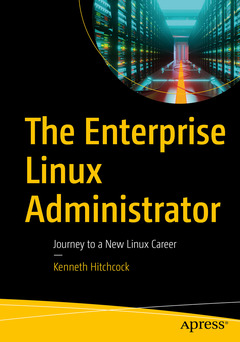The Enterprise Linux Administrator, 1st ed. Journey to a New Linux Career
Auteur : Hitchcock Kenneth

Learn the basics, followed by the more advanced skills you will need to become an Enterprise Linux administrator. This book will prepare you to use Linux effectively with a clearer understanding of what is needed to successfully leverage new opportunities.
By the end of this book, you'll not only learn how to become an Enterprise Linux administrator but will also learn what certifications are vital when competing for new career opportunities.
What You'll Learn
- Install your own Linux environment
- Study the basics to configuring Linux
- Become an Enterprise Linux administrator and how to get there
- Review comprehensive examples on how to use Linux
Who This Book Is For
Those in the IT industry who have no Linux training or experience who wish to learn how to manage a Linux system
This section is a complete introduction to Linux. Its history, what the Operating system is, the different common distributions and how Linux differs from other Operating systems available today.
Chapter 1 : Requirements (10 pages)
Explanation of what skills and knowledge is required before starting in the Linux world.
Recommended reading and studying materials.
Chapter 2 : Origins and Brief History. (10 pages)
Unix past and evolution.
Chapter 3: Linux Explained. (15 pages)
- Basics of the Operating system.
Common Linux distributions
Differences between other Operating systems and Linux.
Many uses of Linux
This section is to start getting hands on Linux and learning how to install.
Chapter 4: Installing Linux for the First Time (65 pages)
Where to get Linux. (5)
Community
Licensing
- Using virtualization. (5)
Windows Virtualization
Exercise
- Libvirt
Exercise
Different vendors
Installing Ubuntu. (15)
- How to create Linux installation media.
Basic Installation
Custom installations.
- Exercise
Installing Fedora (15)
How to create Linux installation media.
Custom installations.
Exercise
Installing OpenSuse (15)
How to create Linux installation media.
Custom installations.
Exercise
Upgrading Linux (10)
What Linux distributions can be upgraded.
Chapter 5: Using Linux for the first time (35)
- Accessing Linux (10)
Console
SSH
- Web console
Exercise
Command line basics.
Command line shortcuts.
- Different commands in different distributions.
Exercise
Desktop basics (15)
- Installing different desktops.
Enabling and Disabling Desktops
Exercise
Command line (10)
SSH and SSHD configuration (8)
Configuration files and starting services.
- Enabling access through Firewall.
Exercise
Users & Groups (8)
Creating users and groups.
Exercise
Exercise
File & directory permissions. (9)
- Chmod, chown, chgrp
Acls
Exercise
Chapter 7: Package Installation (40)
Different package management systems.
Exercise
- Manual package installation.
Exercise
Repository configuration.
- Exercise
Installing packages (20)
System patching (20)
Errata
- Exercise
System updates
Exercise
Exercise
Chapter 8: Network configuration (25)
Network basics in Linux (17)
Configure network configuration with command line.
- Configuring Network configuration with graphical tools.
Configure Network configuration with Desktop.
Exercise
Tools available and how to use them.
Exercise
Chapter 9: Disk Configuration (40)
Disk management (30)
- Tools available
Command line
Graphical
- Exercise
LVM
Create, extend, migrate, destroy
- Raid, mirror, HA
Exercise
Filesystem management (10)
Filesystem types
Creating, extending, resizing
- Exercise
Chapter 10: Service Management (23)
- Basic management (10)
Starting, stopping and viewing services
Exercise
Explained
Exercise
Creating service files.
Enabling and disabling them.
- Exercise
Part 4: Enterprise Linux (200)
Chapter 11: Example use cases for Linux (30)
Building a web server. (15)
- Package installation
Configuring application configuration files
Firewall configuration.
- SELinux configuration
Custom configuration.
Exercise
Automated configuration.
Building a file server. (15)
- Package installation
Configuring application configuration files
Firewall configuration
- SELinux configuration
Custom configuration.
Exercise
Automated configuration.
Chapter 12: Security (46)
Firewall (10)
Explained
- Command line configuration
Console & Web UI configuration
Exercise
Explained
Command line configuration.
- Custom configuration
Exercise
Hardening (15)
Explained.
Different standards.
- Scanning
OpenSCAP
Exercise
Automated remediation.
Encryption (15)
- Explained
Encryption methods
Certificates
Recovery
- Exercise
Network encryption
Chapter 13: High Availability (20)
- Basic HA
Explained.
Ubuntu HA
- Basic guide to simple HA
Exercise
Basic guide to simple HA
Exercise
- Suse HA
Basic guide to simple HA
Exercise
RHEL HA
Chapter 14: Scripting & Automation (24)
Basic shell scripting (12)
- Explained.
Different interpreters.
Exercise
Examples
Ansible (12)
- Explained
Examples
Tools
Exercise
Use cases
Chapter 15: Enterprise Linux Distributions (60)
Red Hat enterprise Linux (20)
- Brief history
Installing RHEL
Subscriptions & Support
Training & Certifications
Estate management basics
Brief History
Installing Ubuntu
- Estate management basics
Subscriptions & Support
Training & certifications
Suse (20)
Brief History
Estate management basics
Subscriptions & Support
Training & certifications
Chapter 16: Deployment at Scale (20)
Methods (5)
Kickstart
- Image clone
Other
Tools (15)
What can be used to deploy Linux systems at scale.
Automation to learn
- Ansible
Salt
Kickstart
Terraform
- Image clone
Examples
Certifications
Puppet
Training
Chapter 17: Troubleshooting Linux (35)
- Logging (20)
Logs, where to find errors
Journalctl
- Increasing verbosity
Understanding Errors
Monitoring (10)
Tools
- Local vs remote
Remote logging
Finding help (5)
Tools
Chapter 18: Recovering from Disaster (20)
- Reinstalling
Knowing when to start over.
Things to consider.
- Recovery mode
Booting into single user mode
Fixing kernel issues
- Resolving disk or mount issues.
Exercise
Recovering using rescue disks
Exercise
Rescue mode
Chapter 19: Backup and Restore (10)
What to backup
- Explained
exercise
What to restore
What to restore
Exercise
T
Work with Linux for the first time and become Enterprise Linux administrators
Explains how to fix your Linux environment if the worst happens
Promoting the adoption and understanding of different Linux distributions
Date de parution : 12-2022
Ouvrage de 602 p.
17.8x25.4 cm
Thème de The Enterprise Linux Administrator :
Mots-clés :
Linux, Enterprise Linux, Fedora, Ubuntu, RHEL, OpenSuse command Line, troubleshooting, Suse



